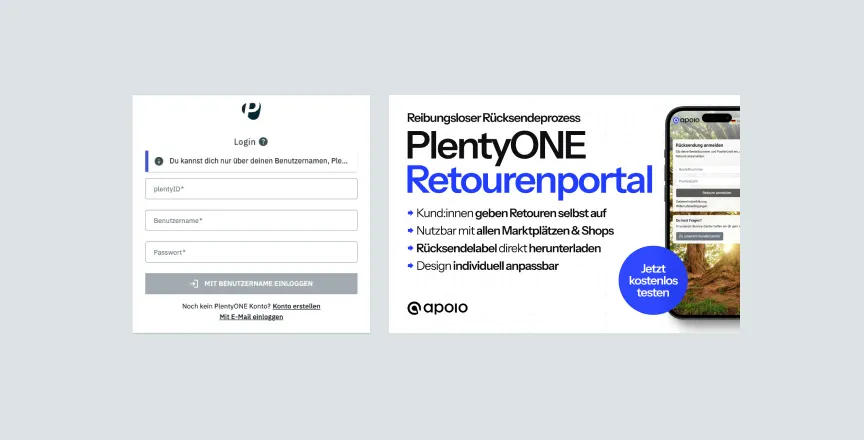It's no longer a secret in e-commerce: if you offer your products not only in your own online store, but also on marketplaces such as Amazon, eBay or OTTO Market, you can increase your reach enormously. For Shopify users in particular, there are many exciting opportunities to present your brand on various platforms and attract new customers. But how does the connection to these marketplaces actually work? What options are there, and what are the pros and cons? That's exactly what we're looking at today.
Why a marketplace connection makes sense for Shopify
Marketplaces such as Amazon, eBay or OTTO Market are no longer just sales platforms - they are search engines for products. Millions of people search for items there every day, and this offers a huge opportunity for retailers who want to make their products accessible to a wider audience. Marketplaces such as Amazon, eBay, Kaufland.de and OTTO Market are extremely popular, especially in German-speaking countries.
If you use Shopify and your products fall into the relevant categories, connecting to such marketplaces is a logical step to increase your own sales. You can sell your products not only in your Shopify store, but also on platforms that already have a huge customer base. This means: more visibility, more sales and, in the best case, more brand awareness.
But - and this is important - connecting to marketplaces is not a sure-fire success. There are different ways you can get your products onto platforms like Amazon or eBay, and each option has its own pros and cons. Let's take a closer look.
Which marketplaces can be connected to Shopify?
There are a number of marketplaces in German-speaking countries that are of interest to Shopify merchants. Here is an overview of the most important platforms:
1. amazon
Amazon is the largest marketplace in the world and also the first port of call for many online shoppers in Germany. The connection to Amazon allows you to present your products to a huge audience. What's particularly exciting is that you can choose between shipping through Amazon (FBA) or your own shipping (FBM).
2. eBay
eBay is still one of the best-known platforms, especially for retailers who sell both new and used items. The connection to eBay is relatively uncomplicated and offers a good opportunity to generate additional sales.
3. OTTO Market
OTTO Market is particularly interesting for retailers who offer high-quality products or branded goods. OTTO attaches great importance to quality and checks retailers before accepting them. If you make it onto this platform, you can benefit from a very affluent target group.
4 Kaufland.de
Kaufland.de (formerly real.de) is a growing marketplace that is particularly suitable for retailers who offer a wide range of products. The platform is less specialized than OTTO Market, but offers a wide reach.
Possibilities of the Shopify marketplace connection
There are various ways in which you can offer your products from Shopify on marketplaces such as Amazon, eBay or OTTO Market. Which option is right for you depends on your requirements, your budget and your technical expertise.
1. apps from the Shopify App Store
The easiest way to connect Shopify with marketplaces is to use apps from the Shopify App Store. There are numerous apps that have been specially developed for connecting to marketplaces. Examples are
- Shopify Marketplace ConnectThis app makes it easy to synchronize products, inventory and prices between Shopify and Amazon, eBay, Etsy and a few American marketplaces such as Walmart or target.
- eBay Integration by CedCommerceWith this app you can list your products on eBay and manage orders directly in Shopify.
- OTTO Market ConnectorSome third-party providers offer apps that have been specially developed to connect to OTTO Market.
Advantages:
- Easy to set up, even without technical know-how.
- Automatic synchronization of stocks, prices and orders.
- Many apps offer support and regular updates.
Disadvantages:
- Monthly costs that vary depending on the app and range of functions.
- Limited customization options.
2. third-party tools
In addition to the apps in the Shopify App Store, there are also external tools that enable a connection to marketplaces. Examples include PlentyONE (formerly plentymarkets), channable and JTL. These tools often offer more extensive functions than the Shopify apps and are particularly suitable for merchants with more complex requirements.
While channable is more of a pure tool for connecting Shopify to other marketplaces and channels, PlentyONE is a complete ERP system. In addition to the pure connection, it offers significantly more extensive functions such as warehouse management, various automation options and a fully-fledged product information management system. If you would like to know more about PlentyONE, take a look at our PlentyONE blog post.
Advantages:
- Support for multiple marketplaces simultaneously.
- Extensive functions such as automated pricing or analysis tools.
- Scalable for larger retailers.
Disadvantages:
- Higher costs than Shopify apps.
- Partially complex setup.
3. individual interface programming
If you want maximum flexibility and control, you can have an individual interface programmed between Shopify and the desired marketplaces. This is particularly useful if you have special requirements that are not covered by standard apps or third-party tools.
Advantages:
- Tailor-made solution that is precisely tailored to your needs.
- No running costs for apps or tools.
- Full control over data and processes.
Disadvantages:
- Higher initial investment for development.
- Dependence on developers for maintenance and updates.
If you are interested in a customized solution, please get in touch with us. As a Shopify agency, we bring together what belongs together and develop connections to all channels and systems.
Advantages and disadvantages of the Shopify marketplace connection
As with every decision in e-commerce, there are pros and cons to connecting to marketplaces that you should weigh up.
Advantages:
- Increased reach: You reach customers who might otherwise never have come across your Shopify store.
- More turnover: Marketplaces offer an additional source of income.
- Brand awareness: Your products are presented on platforms that have millions of users.
Disadvantages:
- Fees: Marketplaces like Amazon or eBay charge selling fees, which can cut into your margin.
- Dependency: If a marketplace changes its policies, this can have a direct impact on your business.
- Additional effort: Managing stock, prices and orders on multiple platforms requires time and resources.
Conclusion
Connecting your Shopify store to marketplaces such as Amazon, eBay or OTTO Market can be a real game changer for your e-commerce business. There are many ways in which you can implement this connection - from simple apps and third-party tools to individual interfaces. Which option is right for you depends on your requirements and your budget.
It is important that you think in advance about which marketplaces are best suited to your products and how you can integrate the additional sales into your existing processes. If you need support with this, we at apoio will of course be happy to assist you. Whether it's choosing the right tools, setting them up or developing a customized solution - we'll help you get the most out of your Shopify store.
.svg)









